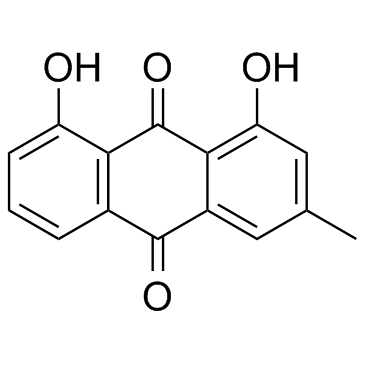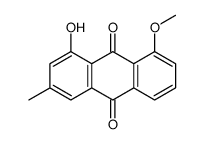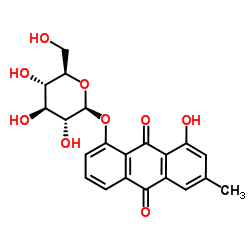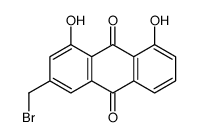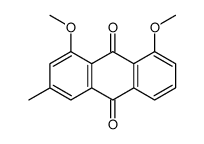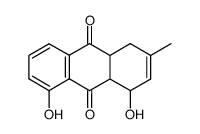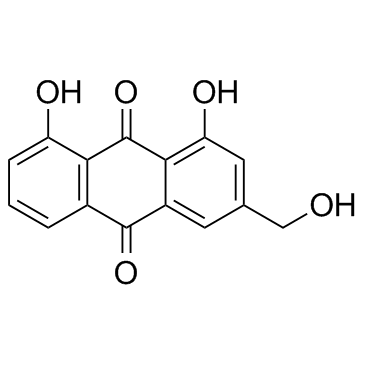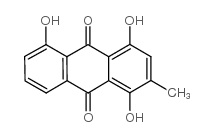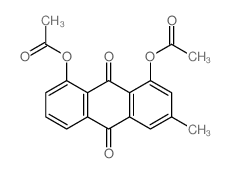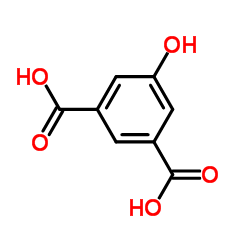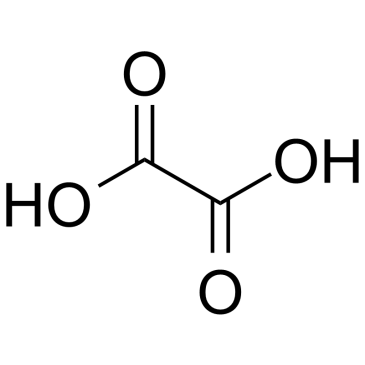481-74-3
| Name | chrysophanol |
|---|---|
| Synonyms |
1,8-dihydroxy-3-methylanthracene-9,10-dione
Chrysophal 2-methyl-4,5-dihydroxy-9,10-anthraquinone CHRYSOPHANOL 1,8-Dihydroxy-3-Methyl-Anthraquinone turkeyrhubarb 1,8-Dihydroxy-3-methyl-9,10-anthraquinone MFCD00001208 1,8-Dihydroxy-3-methylanthra-9,10-quinone 2-Methyl-4,5-dihydroxyanthraquinone Chrysophanic acid C.I. Natural Yellow 23 EINECS 207-572-2 RHUBARB EXTRACT 3-methyl-1,8-dihydroxyanthraquinone 1,8-Dihydroxy-3-methylanthraquinone 1,8-dihydroxy-3-methyl-9,10-antraquinone |
| Description | Chrysophanol (Chrysophanic acid) is a natural anthraquinone, which inhibits EGF-induced phosphorylation of EGFR and suppresses activation of AKT and mTOR/p70S6K. |
|---|---|
| Related Catalog | |
| Target |
EGFR |
| In Vitro | Chrysophanol (Chrysophanic Acid) blocks proliferation of colon cancer cells by inhibiting EGFR/mTOR pathway. Chrysophanol, a natural anthraquinone, has anticancer activity in EGFR-overexpressing SNU-C5 human colon cancer cells. Chrysophanol treatment in SNU-C5 cells inhibits EGF-induced phosphorylation of EGFR and suppresses activation of downstream signaling molecules, such as AKT, extracellular signal-regulated kinase (ERK) and the mammalian target of Rapamycin (mTOR)/ribosomal protein S6 kinase (p70S6K). Chrysophanol (80 and 120 μM) significantly blocks cell proliferation when combined with the mTOR inhibitor, Rapamycin. Chrysophanol inhibits EGF-induced phosphorylation of EGFR and suppresses activation of AKT and mTOR/p70S6K, and significantly blocks cell proliferation. Chrysophanol dose dependently decreases CCK-8 and the viability of EGFR-overexpressing SNU-C5 cells. Chrysophanol treatment dose-dependently decreases EGF induced phosphorylation of EGFR at Tyr1068. Chrysophanol (80 and 120 μM) reduces the phosphorylation levels of mTOR at Ser2448. Chrysophanol (80 and 120 μM) also decreases the phosphorylation levels of p70S6K at Thr389. Chrysophanol inhibits EGF-induced EGFR activation and suppresses activation of the downstream signaling molecules, AKT and mTOR/p70S6K[1]. Chrysophanol (CA) inhibits lipid accumulation in 3T3-L1 adipocytes. Chrysophanol down-regulates adipogenic factors in 3T3-L1 adipocytes. Chrysophanol induces thermogenic factors in primary cultured brown adipocytes. Chrysophanol suppresses adipogenesis and induces thermogenesis via activation of AMPK pathway[2]. |
| In Vivo | Chrysophanol (CA) improves HFD-induced obesity in C57BL/6 Mice. The in vivo performance of Chrysophanol is performed in male C57BL/6J mice to determine the efficacy of administered Chrysophanol. Mice fed the HFD gained significantly more weight than those fed the standard diet mice. On the other hand, weight gain of Chrysophanol group is significantly less than with the untreated HFD. Mice in the HFD-group gained 23.92 ± 1.74 g of weight, while those in the Chrysophanol group gained 16.72±2 g of weight after 16 weeks[2]. |
| Cell Assay | The cells are seeded at 5×103 cells/mL in 96-well microplates and allowed to attach for 24 h. Chrysophanol (20, 50, 80 and 120 μM) is added to the medium at various concentrations up to 120 μM and for different durations. After treatment, cell cytotoxicity and/or proliferation is assessed by a Cell Counting Kit-8 (CCK-8). Briefly, highly water-soluble tetrazolium salt, WST-8, produces an orange colored water-soluble product, formazan. The amount of formazan dye generated by dehydrogenases in cells is directly proportional to the number of living cells.CCK-8 (10 μL) is added to each well and incubated for 3 h at 37°C, then cell proliferation and cytotoxicity are assessed by measuring the absorbance at 450 nm using a microplate reader.Three replicated wells are used for each experimental condition[1]. |
| Animal Admin | Mice[2] Male 4-week-old C57BL/6J mice are maintained for 1 week prior to experiments. Mice are maintained on a 12-h light/dark cycle in a pathogen-free animal facility, provided with laboratory diet and water ad libitum. To induce obesity, the mice are fed a HFD with 60% kcal% fat. Control group (C) are fed a commercial standard chow diet. HFD group (HFD) mice are fed with HFD only. HFD plus CA group (CA) Mice are fed with HFD for 4 weeks before administration of Chrysophanol (5 mg/kg/day). The mice are divided into three groups (n = 5) that are fed chow diet, HFD, and HFD plus Chrysophanol for 16 weeks. Body weight and food intake are measured three times per week. |
| References |
| Density | 1.5±0.1 g/cm3 |
|---|---|
| Boiling Point | 489.5±45.0 °C at 760 mmHg |
| Melting Point | 194-198 °C |
| Molecular Formula | C15H10O4 |
| Molecular Weight | 254.238 |
| Flash Point | 263.9±25.2 °C |
| Exact Mass | 254.057907 |
| PSA | 74.60000 |
| LogP | 5.03 |
| Vapour Pressure | 0.0±1.3 mmHg at 25°C |
| Index of Refraction | 1.710 |
| Storage condition | 2-8°C |
| Stability | Stable. Incompatible with strong oxidizing agents. |
| Water Solubility | <0.1 g/100 mL at 18 ºC |
CHEMICAL IDENTIFICATION
HEALTH HAZARD DATAACUTE TOXICITY DATAMUTATION DATA
|
| Symbol |

GHS07 |
|---|---|
| Signal Word | Warning |
| Hazard Statements | H315-H319 |
| Precautionary Statements | P305 + P351 + P338 |
| Personal Protective Equipment | dust mask type N95 (US);Eyeshields;Gloves |
| Hazard Codes | Xi |
| Risk Phrases | R36/38:Irritating to eyes and skin . R36/37/38:Irritating to eyes, respiratory system and skin . |
| Safety Phrases | S26-S36-S37/39 |
| RIDADR | NONH for all modes of transport |
| WGK Germany | 3 |
| RTECS | CB6725000 |
| HS Code | 2942000000 |
| Precursor 9 | |
|---|---|
| DownStream 10 | |
| HS Code | 2942000000 |
|---|

